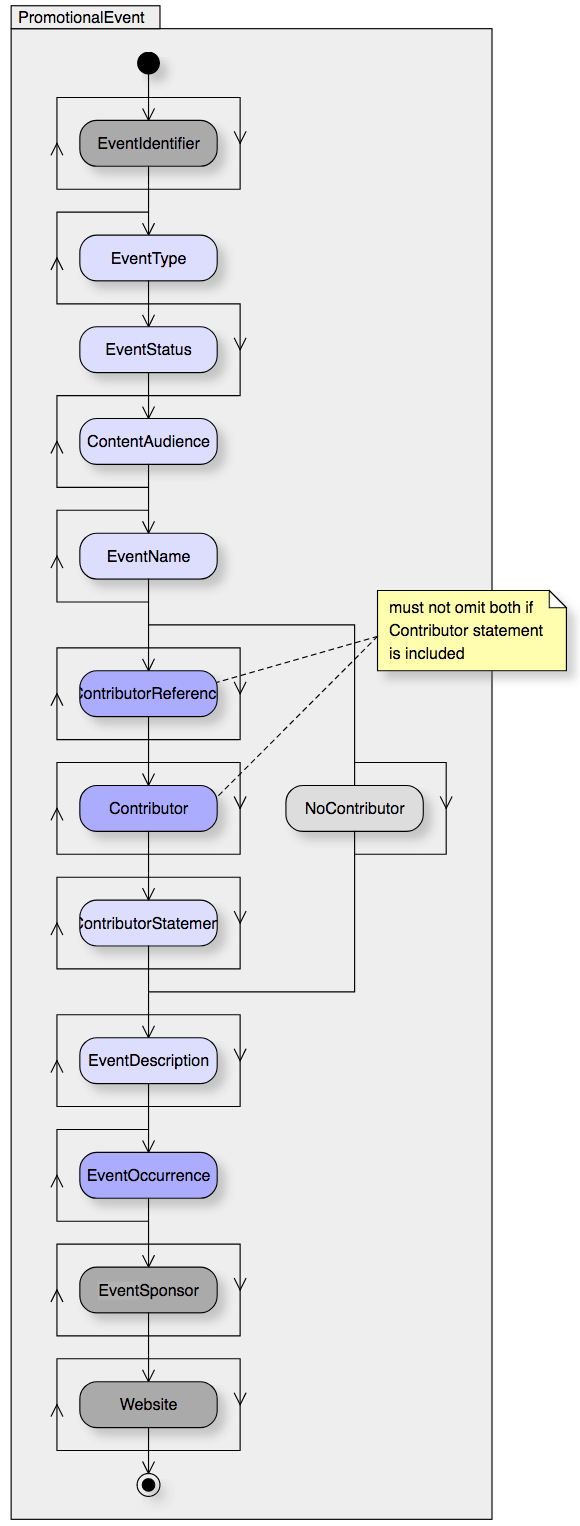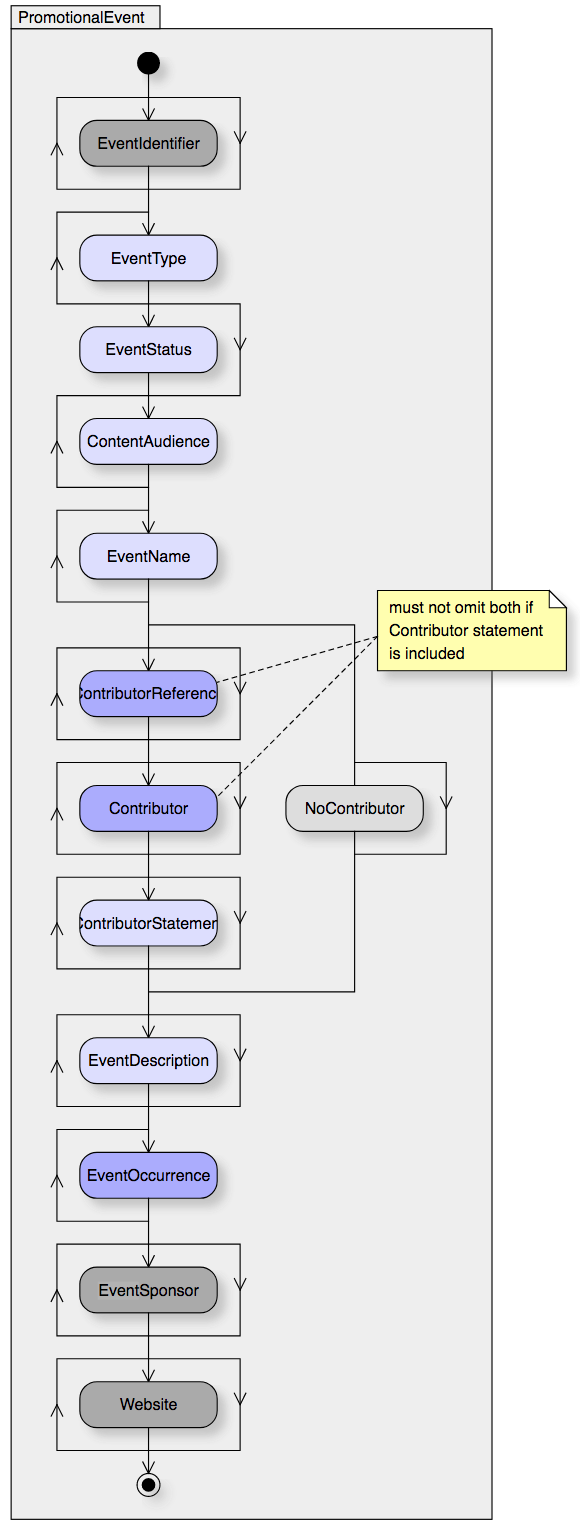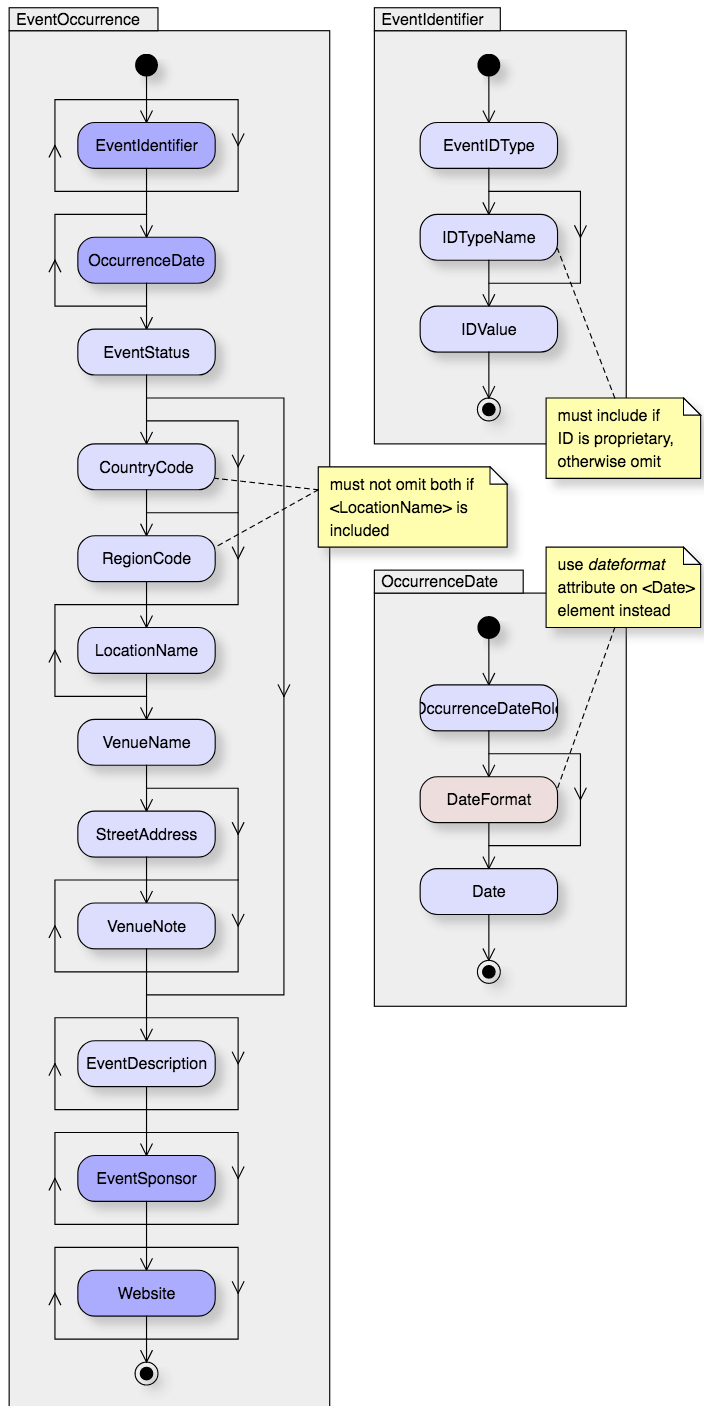...
This contributor is a Canadian citizen who currently lives in Newfoundland & Labrador, specifically in Stephenville.
Using Reference names | Using Short tags |
|---|---|
<ContributorPlace> | <contributorplace> |
Where it gets exciting is that <ContributorPlace> is repeatable, which means you can identify multiple geographical locations, and that <LocationName> is added in 3.0, which is a text field that allows data suppliers to indicate specific cities, neighbourhoods, etc. While <ContributorPlace> in 2.1 supported country and region codes, <LocationName> offers the ability to narrow down and provide even more detailed information. Moreover, <ContributorPlaceRelator>'s codelist is expanded for 3.0:
Value | Description | Notes |
|---|---|---|
01 | Born in | |
02 | Died in | |
03 | Formerly resided in | |
04 | Currently resides in | |
05 | Educated in | |
06 | Worked in | |
07 | Flourished in | (‘Floruit’) |
08 | Citizen of | Or nationality. For use with country codes only |
09 | Registered in | The place of legal registration of an organisation |
10 | Operating from | The place an organisation or part of an organisation is based or operates from |
00 | Associated with | To express unknown relationship types (for use when expressing legacy ONIX 2.1 data in ONIX 3.0) |
You will note that codes 09, 10, and 00 are exclusive to 3.0 as 2.1’s code list for Contributor place relator is frozen at issue 36, while the current codelist for 3.0 is issue 50.
...
ONIX 3.0 completely re-works Product title and Collection unlocking the ability to communicate information about your sets and series better than you ever have! The transition from 2.1 overhauls the concepts of “series” and “sets,” replacing both with the superior term “collection.” The best place to start? Review EDItEUR’s comprehensive reference document available here, but we’ll summarize some of the key points.
As defined in EDItEUR’s ONIX Glossary of Terms:
ONIX 2.1 | ONIX 3.0 |
|---|---|
Series: Continuing and indefinite sequence of monographic products published separately over a period of time, with a shared identity such as a ‘series title’. The products are usually of similar product form, and share a distinctive branding or design style. A series is not available for purchase as a single product. In ONIX, a series is a type of collection. | Collection: Fixed or indefinite number of products that share some collective identity such as a collective title. Members of the collection usually also have other attributes in common, such as product form or a branding or design style. A set or a series is a collection, but a collection could also comprise a less formal selection of products. |
Set: Finite number of products published simultaneously or over a definite period of time, with a shared identity such as a ‘set title’. The products are usually of similar product form, and share a distinctive branding or design style. The products in the set may be available individually, or the set may be a single product, or both. In ONIX, a set is a type of collection. |
When followed, ONIX 3.0 allows for greater clarity without duplication of materials in a way that allows for improved use by retailers and data recipients. BookNet Canada’s metadata guru Tom Richardson documented major changes to how sets and series are handled in ONIX 3.0 in his 2018 blog post: we recommend reading it to better inform your transition as it flags the relatively small changes from ONIX 2.1 that 3.0, including enhancements to the <ProductPart> composite that is widely supported by retailers.
...
This book is an early reader title branded as Mattel’s Barbie toy collection.
Using Reference names | Using Short tags |
|---|---|
<Collection> | <collection> |
There’s much more to say about collections and the opportunities offered by ONIX 3.0: watch this space for a post by Tom Richardson on this very topic! Sign up to BookNet Canada’s eNews or add the Blog’s RSS to be notified.
...
ONIX 2.1 users will be familiar with the many publication dates that must be included in a product record. Block 6 allows sophisticated date management across multiple markets and, accordingly, suppliers. What’s important to note: Block 6 publication dates have supremacy over any publication dates provided in P.20 and P.21.
...
The organization of Block 6 can be summarized by the following table of elements from EDItEUR’s documentation:
Element / Composite | Optional or mandatory? | Repeatability | Notes |
|---|---|---|---|
<ProductSupply> | Optional | Repeatable | All ONIX records should contain at least one Product Supply composite. |
<Market> | Optional | Repeatable | Each Product Supply composite should include the extent of its market |
<Territory> | Mandatory | Non-repeatable | Every Market composite must specify a geographical area |
<SalesRestriction> | Optional | Repeatable | Any sales restrictions that apply within that territory should be included |
</Market> | |||
<MarketPublishingDetail> | Optional | Non-repeatable | Strongly recommended for all Product Supply composites |
<PublisherRepresentative> | Optional | Repeatable | Sales representation support is recommended |
<ProductContact> | Optional | Repeatable | Product contact support is recommended |
<MarketPublishingStatus> | Mandatory | Non-repeatable | Every Market Publishing Detail must contain a Publishing Status |
<MarketDate> | Optional | Repeatable | Market Publication Date is strongly recommended |
</MarketPublishingDetail> | |||
<SupplyDetail> | Mandatory | Repeatable | There must be at least one Supply Detail composite within every Product Supply composite |
<Supplier> | Mandatory | Non-repeatable | Every Supply Detail composite must include a Supplier composite that must include a Supplier Role, business name and should include any applicable identifiers. Contact information and website are recommended |
<ProductAvailability> | Mandatory | Non-repeatable | Every Supply Detail composite must include Product Availability |
<SupplyDate> | Optional | Repeatable | Every Supply Detail should include appropriate dates, in particular by supporting forthcoming books with an embargo date as well as anytime an expected ship date is needed |
<Price> | Optional | Repeatable | Every Supply Detail should contain a price. It can be omitted only if replaced by <UnpricedItemType> |
<PriceType> | Mandatory (don't use default Price Type) | Non-repeatable | All price composites must contain Price Type (and Price Qualifier if needed) to uniquely identify the price amount’s purpose. Additional Price composites can cover each unique statement |
<DiscountCoded> | Optional | Repeatable | All prices should be supported by discount codes |
<PriceAmount> | Optional | Non-repeatable | All price composites should contain a price amount, which cannot be zero. It can be omitted only if replaced by <UnpricedItemType> |
<Tax> | Optional | Repeatable | Tax information should not be sent if the Price Type is coded for “without tax”. Usually needed for European & UK prices |
<CurrencyCode> | Mandatory (don’t use default Currency Code) | Non-repeatable | All price amounts must be assigned a currency code |
<Territory> | Optional | Non-repeatable | All price composites should supply a territory statement to cover where the Price Amount applies to |
<CurrencyZone> | Deprecated | Non-repeatable | Deprecated Do not use. |
</Price> | |||
</SupplyDetail> | |||
</ProductSupply> |
This block is so great, it’s House of Anansi Press' favourite ONIX block:
...
Interested in learning more about the difference between digital products and how they’re handled in ONIX 3.0 vs. 2.1? Read the FAQ here.
...
Target your marketing content for specific audiences
...
Let’s take a look at that list:
Value | Description | Notes |
00 | Unrestricted | Any audience |
01 | Restricted | Distribution by agreement between the parties to the ONIX exchange (this value is provided to cover applications where ONIX content includes material which is not for general distribution) |
02 | Booktrade | Distributors, bookstores, publisher’s own staff etc |
03 | End-customers | |
04 | Librarians | |
05 | Teachers | |
06 | Students | |
07 | Press | Press or other media |
08 | Shopping comparison service | Where a specially formatted description is required for this audience |
09 | Search engine index | Text not intended for display, but may be used (in addition to any less restricted text) for indexing and search |
Additionally, it’s important to note the suggested use for <ContentAudience>:
...
The savvy reader’s mind is blown – we know. Imagine the possibilities! When matched with the potential <TextType>s in list 153, the potential for precise, differentiated content to reach the desired audience is almost endless. Let’s take a look at that list:
Value | Description | Notes |
|---|---|---|
01 | Sender-defined text | To be used only in circumstances where the parties to an exchange have agreed to include text which (a) is not for general distribution, and (b) cannot be coded elsewhere. If more than one type of text is sent, it must be identified by tagging within the text itself |
02 | Short description/annotation | Limited to a maximum of 350 characters |
03 | Description | Length unrestricted |
04 | Table of contents | Used for a table of contents sent as a single text field, which may or may not carry structure expressed using XHTML |
05 | Flap / cover copy | Primary descriptive blurb taken from the back cover and/or flaps. See also code 27 |
06 | Review quote | A quote taken from a review of the product or of the work in question where there is no need to take account of different editions |
07 | Review quote: previous edition | A quote taken from a review of a previous edition of the work |
08 | Review quote: previous work | A quote taken from a review of a previous work by the same author(s) or in the same series |
09 | Endorsement | A quote usually provided by a celebrity or another author to promote a new book, not from a review |
10 | Promotional headline | A promotional phrase which is intended to headline a description of the product |
11 | Feature | Text describing a feature of a product to which the publisher wishes to draw attention for promotional purposes. Each separate feature should be described by a separate repeat, so that formatting can be applied at the discretion of the receiver of the ONIX record, or multiple features can be described using appropriate XHTML markup |
12 | Biographical note | A note referring to all contributors to a product – NOT linked to a single contributor |
13 | Publisher’s notice | A statement included by a publisher in fulfillment of contractual obligations, such as a disclaimer, sponsor statement, or legal notice of any sort. Note that the inclusion of such a notice cannot and does not imply that a user of the ONIX record is obliged to reproduce it |
14 | Excerpt | A short excerpt from the main text of the work |
15 | Index | Used for an index sent as a single text field, which may be structured using XHTML |
16 | Short description/annotation for collection | (of which the product is a part.) Limited to a maximum of 350 characters |
17 | Description for collection | (of which the product is a part.) Length unrestricted |
18 | New feature | As code 11 but used for a new feature of this edition or version |
19 | Version history | |
20 | Open access statement | Short summary statement of open access status and any related conditions (eg ‘Open access – no commercial use’), primarily for marketing purposes. Should always be accompanied by a link to the complete license (see <EpubLicense> or code 99 in List 158) |
21 | Digital exclusivity statement | Short summary statement that the product is available only in digital formats (eg ‘Digital exclusive’). If a non-digital version is planned, <ContentDate> should be used to specify the date when exclusivity will end (use content date role code 15). If a non-digital version is available, the statement should not be included |
22 | Official recommendation | For example, a recommendation or approval provided by a ministry of education or other official body. Use <Text> to provide details and ideally use <TextSourceCorporate> to name the approver |
23 | JBPA description | Short description in format specified by Japanese Book Publishers Association |
24 | schema.org snippet | JSON-LD snippet suitable for use within an HTML <script type="application/ld+json"> tag, containing structured metadata suitable for use with schema.org |
25 | Errata | |
26 | Introduction | Introduction, preface or the text of other preliminary material, sent as a single text field, which may be structured using XHTML |
27 | Secondary flap / cover copy | Secondary descriptive blurb taken from the back cover and/or flaps, used only when there are two separate texts and the primary text is included using code 05 |
28 | Full cast and credit list | For use with dramatized audiobooks, filmed entertainment etc, for a cast list sent as a single text field, which may or may not carry structure expressed using XHTML |
29 | Bibliography | Complete list of books by the author(s), supplied as a single text field, which may be structured using (X)HTML |
30 | Abstract | Formal summary of content (normally used with academic and scholarly content only) |
Mix & match <ContentAudience> with <TextType> and you’re going to have some very happy marketing colleagues. After all, happy colleagues, happy life!
...
The structure of these two composites allows a data provider to share detailed information about specific events:
The <PromotionalEvent> composite | The <EventOccurrence> composite |
|---|
All of that to say that anything and everything about your events can be communicated to data recipients in the <PromotionalEvent> composite:
...
This Block and its <PromotionalEvent> composite are the stuff of dreamdreams, truly. Media, bookstores, and libraries have long requested data about book events to anticipate and respond to local demand. Providing this in a standardized form through product metadata saves time across the publicity, sales, and marketing departments of many publishing houses!
...
Let’s see how it looks, using the ONIX record for Zalika Reid-Benata’s Frying Plantain:
Using Reference names | Using Short tags |
|---|---|
<Prize> | <prize> |
P.7 Authorship
This is where ONIX 3.0 will satisfy the most Type A personalities among us: the long-awaited opportunity to specify prizing information that’s specific to the contributor, independent from the product! Just as <Contributor> is a repeatable composite, <Prize> may be repeated per contributor. <Prize> is an “associated attribute” of the <Contributor> and includes all the same components as you’re familiar with from p.17 Prizes. In the <Contributor> composite, you may list general awards given to a contributor as well as awards given to a contributor for other works and products. Just imagine the opportunities! We know, it’s pretty sweet.
...


